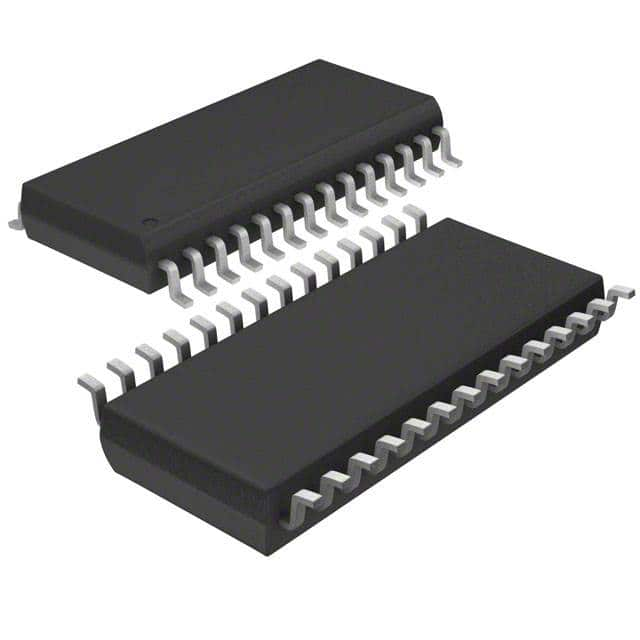Lihat spesifikasi untuk detail produk.

TLC59116ITPWRQ1
Product Overview
Category
TLC59116ITPWRQ1 belongs to the category of integrated circuits (ICs).
Use
This product is commonly used for driving LEDs (Light Emitting Diodes) in automotive applications.
Characteristics
- TLC59116ITPWRQ1 is a 16-channel constant current LED driver.
- It operates with a supply voltage range of 3V to 5.5V.
- The device supports both dot correction and brightness control.
- It offers a wide dimming range, allowing precise control over LED brightness levels.
- This LED driver is designed to meet the stringent requirements of automotive applications.
Package
TLC59116ITPWRQ1 is available in a small outline package (SOP) with a thermal pad for enhanced heat dissipation.
Essence
The essence of TLC59116ITPWRQ1 lies in its ability to efficiently drive multiple LEDs in automotive lighting systems, ensuring optimal performance and reliability.
Packaging/Quantity
This product is typically packaged in reels, containing a specified quantity of units per reel. The exact packaging and quantity may vary depending on the supplier.
Specifications
- Supply Voltage Range: 3V to 5.5V
- Number of Channels: 16
- Maximum Output Current per Channel: 120mA
- Dimming Control: Dot correction and brightness control
- Thermal Pad: Yes
Detailed Pin Configuration
The TLC59116ITPWRQ1 features a 24-pin SOP package with the following pin configuration:
- GND - Ground
- SDA - Serial Data Input
- SCL - Serial Clock Input
- VCC - Power Supply Voltage
- OE - Output Enable
- IREF - Reference Current
- OUT0 - Channel 0 Output
- OUT1 - Channel 1 Output
- OUT2 - Channel 2 Output
- OUT3 - Channel 3 Output
- OUT4 - Channel 4 Output
- OUT5 - Channel 5 Output
- OUT6 - Channel 6 Output
- OUT7 - Channel 7 Output
- OUT8 - Channel 8 Output
- OUT9 - Channel 9 Output
- OUT10 - Channel 10 Output
- OUT11 - Channel 11 Output
- OUT12 - Channel 12 Output
- OUT13 - Channel 13 Output
- OUT14 - Channel 14 Output
- OUT15 - Channel 15 Output
- VCC - Power Supply Voltage
- GND - Ground
Functional Features
- Constant current output for driving LEDs.
- Dot correction allows precise adjustment of individual LED brightness.
- Brightness control enables dimming of LEDs over a wide range.
- Output enable pin for easy on/off control.
- Thermal pad enhances heat dissipation, ensuring reliable operation in automotive environments.
Advantages and Disadvantages
Advantages
- High precision and accuracy in driving multiple LEDs.
- Wide dimming range for flexible brightness control.
- Designed specifically for automotive applications, meeting stringent requirements.
- Enhanced thermal management for improved reliability.
Disadvantages
- Limited to driving LEDs and not suitable for other types of loads.
- Requires external components for proper operation.
Working Principles
TLC59116ITPWRQ1 operates by receiving serial data input (SDA) and serial clock input (SCL) signals. It converts this input into constant current outputs for driving LEDs. The device supports dot correction, allowing individual LED brightness adjustment. Additionally, it offers a wide dimming range through brightness control, enabling precise control over LED brightness levels.
Detailed Application Field Plans
TLC59116ITPWRQ1 finds extensive application in automotive lighting systems, including:
- Exterior lighting: Headlights, taillights, turn signals, and brake lights.
- Interior lighting: Dashboard illumination, instrument cluster, and ambient lighting.
- Safety lighting: Daytime running lights (DRLs) and fog lights.
The product's high precision, wide dimming range, and thermal management make it suitable for various automotive lighting requirements.
Detailed and Complete Alternative Models
- TLC59108IPWR: 8-channel constant current LED driver with similar features.
- TLC59108IPW: 8-channel constant current LED driver in a different package.
- TLC59116IPWR: 16-channel constant current LED driver in a different package.
These alternative models offer similar functionality and can be considered as alternatives to TLC59116ITPWRQ1 based on specific application requirements.
Word count: 609 words
Sebutkan 10 pertanyaan dan jawaban umum terkait penerapan TLC59116ITPWRQ1 dalam solusi teknis
Sure! Here are 10 common questions and answers related to the application of TLC59116ITPWRQ1 in technical solutions:
1. What is the TLC59116ITPWRQ1? - The TLC59116ITPWRQ1 is a 16-channel constant-current LED driver with an I2C interface.
2. What is the maximum output current per channel? - The TLC59116ITPWRQ1 can provide a maximum output current of 120 mA per channel.
3. Can the TLC59116ITPWRQ1 be used for driving RGB LEDs? - Yes, the TLC59116ITPWRQ1 can be used to drive RGB LEDs by controlling the individual channels.
4. How many TLC59116ITPWRQ1 devices can be connected together? - Multiple TLC59116ITPWRQ1 devices can be connected together using the I2C bus, allowing control of more than 16 channels.
5. What is the supply voltage range for the TLC59116ITPWRQ1? - The TLC59116ITPWRQ1 operates with a supply voltage range of 3 V to 5.5 V.
6. Can the TLC59116ITPWRQ1 be used in automotive applications? - Yes, the TLC59116ITPWRQ1 is designed for automotive applications and is AEC-Q100 qualified.
7. Does the TLC59116ITPWRQ1 have built-in thermal shutdown protection? - Yes, the TLC59116ITPWRQ1 has built-in thermal shutdown protection to prevent overheating.
8. Can the TLC59116ITPWRQ1 dim the LEDs? - Yes, the TLC59116ITPWRQ1 supports LED dimming through pulse-width modulation (PWM) control.
9. What is the maximum frequency for PWM dimming? - The TLC59116ITPWRQ1 supports PWM dimming with a maximum frequency of 30 kHz.
10. Is there any evaluation board available for the TLC59116ITPWRQ1? - Yes, Texas Instruments provides an evaluation board (TLC59116EVM-764) for testing and prototyping with the TLC59116ITPWRQ1.
Please note that these answers are general and may vary depending on the specific application and requirements.

